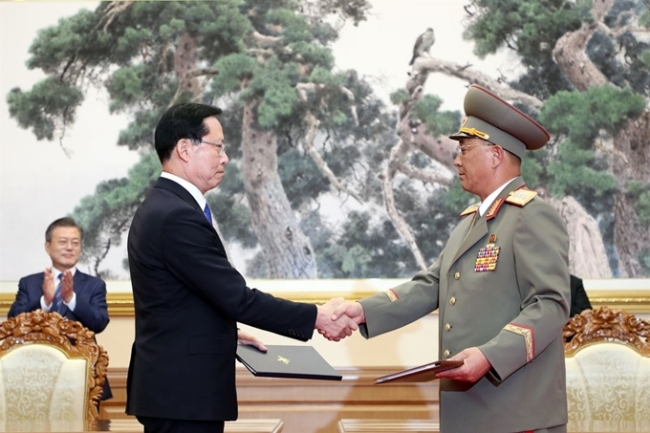No-fly zone: Prudent trust-building step or reckless concession?
By Yeo Jun-sukPublished : Oct. 21, 2018 - 15:57
Controversy continues to grow over South Korea’s plan to establish a no-fly zone along the border with North Korea, prompting debate over the question of building trust with Pyongyang without compromising the military’s reconnaissance capabilities.
The two Koreas’ defense chiefs agreed last month to ban aircraft flights over the heavily fortified Demilitarized Zone and the surrounding area. The agreement was signed following a summit between President Moon Jae-in and North Korean leader Kim Jong-un in Pyongyang on Sept. 19.
The Moon Jae-in administration maintains that the measure is crucial to addressing the lack of military trust between the two countries, suggesting that preventing accidental clashes between forward-deployed units is key to reducing the risk of minor skirmishes escalating into an all-out war.
“No-fly zone is essentially a confidence-building measure. … Flying so close to the border area can be a source of major accidental military clashes,” President Moon’s special adviser Moon Chung-in told The Korea Herald at a security forum in Seoul last week.

Effective Nov. 1, the two Koreas will be banned from flying fighter jets, choppers, drones and even balloons inside the no-fly zone. The zone extends 40 kilometers north and south of the Military Demarcation Line in the east and 20 kilometers in the west for fixed-wing aircraft.
The Defense Ministry said while the measure limits the capability to monitor North Korea’s massive front-line units, the gap can easily be bridged by more advanced reconnaissance assets employed by superior commands and US Forces Korea.
There might be a “slight impact” when the Army conducts tactical reconnaissance with drones and the Air Force collects imagery intelligence, but South Korea’s multilayered surveillance capabilities can minimize the gap, the Army and Air Force chiefs said.
“Employing Unmanned Aerial Vehicles held by corps-level units can be partly limited,” Army Chief of Staff Gen. Kim Yong-woo told the lawmakers Thursday. “But superior command’s units are sufficiently capable of dealing with (North Korea’s) tactical units.”
Air Force Chief of Staff Gen. Lee Wang-geun agreed. In a meeting with lawmakers Friday, Lee said the restriction could diminish the scope of the surveillance area by aircraft, but the loss was trivial and could be compensated for by the USFK’s advanced assets.
However, concern persists among security experts that establishing a no-fly zone is a reckless step to pursue with North Korea, whose nuclear weapons and massive conventional forces pose a significant threat to South Korea.
Given that airpower is one of the rare areas where South Korea enjoys an advantage over North Korea thanks to advanced assets from the US Air Force, imposing restrictions on the allies’ air forces is too much of a concession, security experts said.
“I’m afraid the South Korean military has become blinded, unable to see what North Korea is doing,” said retired Lt. Gen. Shin won-sik, who served as Vice Chairman of the Joint Chiefs of Staff before leaving the Army in 2016.
“North Korea’s advantage in asymmetric capabilities can only be offset by South Korea’s advanced surveillance, reconnaissance and precision-strike capabilities. Establishing a no-fly zone has killed such capabilities.”
In particular, Shin warned that the measure might undermine the military’s ability to detect surprise attacks from North Korea, especially those from massive artillery units positioned along the DMZ.
North Korea has stationed massive artillery units capable of hitting Seoul with tens of thousands of rounds within the first hour of a conflict. While the inter-Korean detente has raised the hope that the artillery units might be withdrawn, no such agreement was made between the two Koreas.
Shin In-gyun, president of the Korea Defense Network, believes that establishing a no-fly zone is a strategic mistake. Given that North Korea’s surveillance and airpower lag far behind that of South Korea, he said, the military agreement favors Pyongyang.
“Now there is a significant gap between the two Koreas in terms of airpower and reconnaissance capabilities. … Speaking about the capabilities that North Korea doesn’t possess, it seems that we struck a deal that only ends up neutralizing our capabilities,” said Shin.
By Yeo Jun-suk(jasonyeo@heraldcorp.com)









![[Kim Seong-kon] Democracy and the future of South Korea](http://res.heraldm.com/phpwas/restmb_idxmake.php?idx=644&simg=/content/image/2024/04/16/20240416050802_0.jpg&u=)









![[Today’s K-pop] Zico drops snippet of collaboration with Jennie](http://res.heraldm.com/phpwas/restmb_idxmake.php?idx=642&simg=/content/image/2024/04/18/20240418050702_0.jpg&u=)